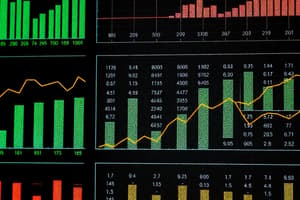Podcast
Questions and Answers
Florence Nightingale used graphical displays of data primarily to:
Florence Nightingale used graphical displays of data primarily to:
- Showcase her skills in data visualization to gain recognition in the medical field.
- Help in understanding the data related to deaths and to advocate for better sanitation practices.
- Document the exact number of deaths in the Crimean War for historical records. (correct)
- Display the relationships between different variables in Crimean War deaths.
Which statement correctly describes the relationship between descriptive statistics and making inferences?
Which statement correctly describes the relationship between descriptive statistics and making inferences?
- Making inferences is a prerequisite for descriptive statics.
- Descriptive statistics are unnecessary when making inferences, as inferences are based on raw data. (correct)
- Descriptive statistics allow us to make inferences without needing to understand the underlying data.
- Inferences are based on facts quantified by descriptive statistics, which provide a summary of the data.
A researcher observes that a dataset has high variability. According to the material, what does this indicate?
A researcher observes that a dataset has high variability. According to the material, what does this indicate?
- The number of data points in the data set is low.
- The researcher should consider the level of uncertainty associated with any observed patterns.
- The patterns observed in the dataset are very accurate and reliable. (correct)
- The researcher can be very certain about any patterns they identify.
Why are accurate descriptions of a sample so crucial when making inferences about a population?
Why are accurate descriptions of a sample so crucial when making inferences about a population?
A study aims to determine the average height of adults in a city. Which of the following must be addressed to ensure accurate inferences?
A study aims to determine the average height of adults in a city. Which of the following must be addressed to ensure accurate inferences?
What is the primary purpose of visualizing data, according to the material?
What is the primary purpose of visualizing data, according to the material?
A graph contains several distracting visual elements that do not contribute to understanding the data. This is an example of:
A graph contains several distracting visual elements that do not contribute to understanding the data. This is an example of:
A researcher manipulates the axis scales on a graph to exaggerate the differences between two groups. This action directly affects the:
A researcher manipulates the axis scales on a graph to exaggerate the differences between two groups. This action directly affects the:
When is the median a better measure of central tendency than the mean?
When is the median a better measure of central tendency than the mean?
How does a histogram help in understanding a dataset?
How does a histogram help in understanding a dataset?
Flashcards
Graphical Data Displays
Graphical Data Displays
Using graphs to help understand data; pioneered by Florence Nightingale.
Descriptive Statistics
Descriptive Statistics
Summaries and patterns (not inferences) to help understand a dataset, quantify uncertainty, and describe patterns.
Inference
Inference
Statements using facts obtained from datasets and accurate descriptions of data.
Chart-Junk
Chart-Junk
Signup and view all the flashcards
Lie Factor
Lie Factor
Signup and view all the flashcards
Data-Ink Ratio
Data-Ink Ratio
Signup and view all the flashcards
Central Tendency
Central Tendency
Signup and view all the flashcards
Arithmetic Mean
Arithmetic Mean
Signup and view all the flashcards
Median
Median
Signup and view all the flashcards
Mode
Mode
Signup and view all the flashcards
Study Notes
Basic Summaries of Data
- Graphical displays are useful in understanding data.
- Florence Nightingale used a Rose diagram/Polar Area diagram to show excess deaths related to the Crimean War due to poor sanitation in hospitals and documented prevention strategies.
Descriptive Statistics
- Descriptive statistics are essential for understanding a dataset, allowing one to observe patterns.
- Data summaries are required before conclusions can be made.
- Raw data typically has too much detail.
- Most studies use samples, and descriptive statistics can help quantify uncertainty in the sample.
- Making inferences is not possible without descriptive statistics.
- Descriptive statistics quantify facts and support inferences.
Descriptive Statistics Definition and Importance
- Descriptive statistics analyze data to produce meaningful summaries related to data patterns and uncertainty.
- Patterns describe how data varies across groups/conditions and relationships between variables.
- Uncertainty describes the variability within a dataset.
- Descriptive statistics use facts that describe a specific dataset, capturing how well a sample fits its population, and allow estimations about a population.
- Statistics help to understand the world, gain insight and describe the collected data.
- Descriptive statistics are "estimators," telling about a population.
- Without accurate sample descriptions, making good inferences is impossible.
- Statistics deals with making choices with incomplete information, quantifying uncertainty, and making categorical statements.
Inferences
- Accurate data descriptions and experimental design, representative samples, and accurate theories are required for accurate inferences.
- Good experimental design accounts for extraneous/confounding variables.
- Representative samples ensure the population accurately represents the group to whom the theory applies.
- Accurate theories are close enough to the truth to be reasonable.
- Inferences start with facts obtained from datasets, which include population, sampling and randomization methods, variable relationships, and data distribution (range, quartiles, standard deviation, variance, and central tendencies).
Visualizing Summaries
- Data visualization supports pattern identification and inference.
- Different datasets can display the same descriptive statistics but have different distributions.
Graphical Representations
- Graphs are an effective way to understand data, providing overviews, pattern information, and quick understanding.
- Simplify and organize data clearly.
Graph Characteristics
- Graphs should be free of "chart-junk," have a low "lie factor," and a high "data:ink ratio."
- Chart-junk consists of distracting visual elements that reduce understanding and viewer interest.
- The lie factor measures how precisely a graphic represents the underlying data.
- Data-ink ratio refers to the proportion of a graphic's ink devoted to displaying data and affecting interpretability.
Central Tendency
- Indicates the "average" data point, calculating arithmetic mean (average), which is the sum of numbers divided by the count.
- The median is the middle value, or the 50th percentile in a data set.
- The mode is the most common value(s).
Histograms
- Histograms represent data distribution, plotting individual X-axis values and Y-axis counts.
- Histograms show how data is distributed, its distribution type, how it's distributed in a larger population, how representative the sample is, and how frequent some values are.
Anatomy of plots
- Box plots graphically represent data distribution, including IQR, min/max values, outliers, and quartiles.
- Violin plots are graphical representations combining elements of a box plot with a kernel density plot; depicting numeric data distributions through density curves.
Dispersion
- Provides measures illustrating to what extent data points are spread out.
Range and Variance
- Range is the maximum value minus the minimum value.
- Interquartile range (IQR) is the 75th minus the 25th percentile.
- Variance reflects the average squared deviation from the mean.
- Standard deviation shows the average deviation from the mean, expressed in original units.
Studying That Suits You
Use AI to generate personalized quizzes and flashcards to suit your learning preferences.
Related Documents
Description
Explore the role of graphical displays and descriptive statistics in understanding data patterns and uncertainty. Learn how descriptive statistics are used to analyze data and produce meaningful summaries, quantify facts, and support inferences in research studies.



